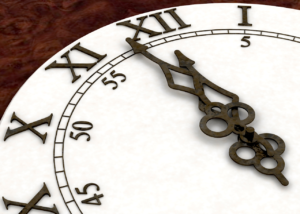During normal times, on New Year’s Eve people would be looking forward to parties and fireworks to help them welcome in the coming year. However, these remain uncommon times. Some people find it curious that the last day of the year is called New Year’s Eve rather than something like Reflection Day — a day for looking back on the past year rather than looking forward to the new one. Scholars point to a religious origin for this practice of celebrating important “eves,” although there is still some debate on this point. Theologian J. Amanda McGuire explains, “There has been significant debate over when the biblical day begins. Certain biblical texts seem to indicate that the day begins in the morning and others that it begins in the evening. Scholars long believed that the day began at sunset, according to Jewish tradition. Jews begin their religious holidays in the evening, and the biblical text mandates that the two most important religious feasts, the Passover and the Day of Atonement, begin at sunset.”[1]
Another online commentator wrote this, “The use of sunset to mark the beginning of the day was common throughout the West thanks to Jewish tradition, as adopted by Christians, which still marks religious days this way. Why is probably twofold: it’s very convenient, requiring no timekeeping devices to track, and; because darkness didn’t follow light in creation, it preceded it. … The Romans were one of the cultures that marked the start of the day at midnight rather than at sunset. To this day, we refer to the half day before midday as a.m. (ante meridiem) and the half day after midday p.m. (post meridiem). The use of twelve hours to mark a half day appears to have originated with the Roman Law of Twelve Tables, a foundational legal code, with each hour a reminder of one of the laws.”[2]
If the use of sunset to mark the beginning of the day was “common throughout the West,” there isn’t a wealth of evidence to support that claim. A Google search on the subject points mostly to Judeo-Christian religious websites. Retired physicist Peter Diehr provides this explanation, “Some societies use sunset as the end of one day, and the start of the next: this is recorded in Genesis, chapter 1; for example, the Athenians, or see the Jewish civil day. Some traditional agricultural societies start the day with dawn, but Roman civil society defined the day as beginning at midnight. The day was divided into ante meridiem (am) and post meridiem (pm), where the meridian refers to local noon. Twelve hours later is midnight, the sixth hour of the night, and the beginning of the next day. … The Roman’s borrowed their system from the Greeks, who in turn had learned it from the Babylonians. Western European timekeeping conventions come directly from Roman practices, and have spread around the world in recent times, but are not universal.”[3]
Here’s my theory. Revelers pushed the idea that important holidays start at sunset so they could start the party early and keep it going throughout the night. These party animals simply used religious tradition as a pretext to garner support for their festive intentions. The three most popular “eves” in the West are Halloween (i.e., the evening before All Hallows Day); Christmas Eve, and New Year’s Eve all offer a great excuse for a party. Admittedly, I have no evidence to back up this theory. But I do know Halloween, Christmas, and New Year’s Eve parties remain popular. According to History.com, “The earliest recorded festivities in honor of a new year’s arrival date back some 4,000 years to ancient Babylon. For the Babylonians, the first new moon following the vernal equinox — the day in late March with an equal amount of sunlight and darkness — heralded the start of a new year.”[4]
Start of the New Year
Before discussing how you might best celebrate this evening. You might be interested to learn why the beginning of the New Year was moved to January from March. Journalist Borgna Brunner, explains:
“The early Roman calendar designated March 1 as the new year. The calendar had just ten months, beginning with March. That the new year once began with the month of March is still reflected in some of the names of the months. September through December, our ninth through twelfth months, were originally positioned as the seventh through tenth months (septem is Latin for ‘seven,’ octo is ‘eight,’ novem is ‘nine,’ and decem is ‘ten.’ … The first time the new year was celebrated on January 1st was in Rome in 153 B.C. (In fact, the month of January did not even exist until around 700 B.C., when the second king of Rome, Numa Pontilius, added the months of January and February.) The new year was moved from March to January because that was the beginning of the civil year, the month that the two newly elected Roman consuls — the highest officials in the Roman republic — began their one-year tenure. But this new year date was not always strictly and widely observed, and the new year was still sometimes celebrated on March 1. … In 46 B.C., Julius Caesar introduced a new, solar-based calendar that was a vast improvement on the ancient Roman calendar, which was a lunar system that had become wildly inaccurate over the years. The Julian calendar decreed that the new year would occur with January 1, and within the Roman world, January 1 became the consistently observed start of the new year.”
Brunner goes on to explain that some religionists didn’t appreciate the partying associated with the beginning of the New Year, believing them to “pagan and unchristian like.” As a result, “in 567 the Council of Tours abolished January 1 as the beginning of the year. At various times and in various places throughout medieval Christian Europe, the new year was celebrated on Dec. 25, the birth of Jesus; March 1; March 25, the Feast of the Annunciation; and Easter.” According to Brunner this confusion reigned until 1582, when the “Gregorian calendar reform restored January 1 as new year’s day. Although most Catholic countries adopted the Gregorian calendar almost immediately, it was only gradually adopted among Protestant countries. The British, for example, did not adopt the reformed calendar until 1752. Until then, the British Empire — and their American colonies — still celebrated the new year in March.” Pretty much the whole world now uses the Gregorian calendar. So let the parties begin — using Covid protocols, of course.
Eat, Drink, and Be Merry
Over the years, a number of traditions have been associated with New Year’s Eve celebrations. If you’re looking for ideas to liven up your New Year’s Eve festivities, you might incorporate one or more of these traditions into your party activities.
Kissing a loved one. This is probably the best of all traditions. Marisa LaScala (@mar_to_go) reports, “When the clock strikes midnight, you’re supposed to kiss someone you love. According to the Washington Post, this is borrowed from English and German folklore, which stated that it’s ‘the first person with whom a person came in contact that dictated the year’s destiny,’ so don’t choose your kissing partner willy-nilly.”[6]
Making noise. Almost everyone is familiar with this tradition. From lighting off fireworks to blowing on noisemakers to banging on pots and pans, people like to make noise as the old year turns into the new. Journalist Victoria Doudera reports, “In ancient Thailand, guns were fired to frighten off demons. In China, firecrackers routed the forces of darkness. In the early American colonies, the sound of pistol shots rang through the air. [And] today, Italians let their church bells peal, [while] the Swiss beat drums.”[7]
Eating lucky food. Although there are a number of food traditions associated with New Year’s Eve, two of the most widely reported on are eating Hoppin’ John and grapes. Food journalist Amanda Kludt (@kludt) reports, “A major New Year’s food tradition in the American South, Hoppin’ John is a dish of pork-flavored field peas or black-eyed peas (symbolizing coins) and rice, frequently served with collards or other cooked greens (as they’re the color of money) and cornbread (the color of gold). The dish is said to bring good luck in the new year.”[8] Journalist Jolie Lee (@JolieLeeDC) reports, “In Spain and some other Spanish-speaking countries, one New Year’s custom is to eat 12 grapes for 12 months of good luck. But here’s the catch: to bring about a year’s worth of good fortune, you must start eating the grapes when the clock strikes midnight, then eat one for each toll of the clock.”[9] Kludt reports other “lucky foods” include tamales in Mexico, oliebollen in the Netherlands, marzipanschwein in Germany, soba noodles in Japan, and pickled herring in Scandinavia.
Drinking. If you’re going to eat, you might as well drink. Doudera writes, “Although the pop of a champagne cork signals the arrival of the New Year around the world, some countries have their own beverage-based traditions. Wassail, a punch-like drink named after the Gaelic term for ‘good health,’ is served in some parts of England. Spiced ‘hot pint’ is the Scottish version of Wassail. … In Holland, toasts are made with hot, spiced wine.” LaScala notes, “In Russia, everyone writes down a wish for the next year, burns the paper they wrote it on, dumps the ashes in a glass of Champagne, then drinks it before midnight. Maybe, in this case, the regular toast will suffice?”
Singing. Lee reports, “The song [Auld Lang Syne] literally means ‘old long ago.’ The work by 18th-century Scottish poet Robert Burns has endured the ages and spread beyond Scotland and throughout the English-speaking world. The song is about ‘the love and kindness of days gone by, but … it also gives us a sense of belonging and fellowship to take into the future,’ according to Scotland.org.” I suspect with all the drinking that goes on New Year’s Eve, there is always some type of singing that accompanies the partying.
Concluding Thoughts
Thomas Jefferson once stated, “I like the dreams of the future better than the history of the past,” but history is important. Before you start to party, take a little time to reflect on the past year. Such reflection might enlighten you to your nature as either an optimist or a pessimist. “An optimist stays up until midnight to see the new year in,” wrote writer and humorist Bill Vaughan. “A pessimist stays up to make sure the old year leaves.” Whether you plan on celebrating at home or partying out with friends, please celebrate safely.
Footnotes
[1] J. Amanda McGuire, “Evening or Morning: When Does the Biblical Day Begin?” Andrews University Seminary Studies, Vol. 46, No. 2, 201-214, 2008.
[2] Barking at the Moon, “When did a day begin for medieval societies, sunset or sunrise?” Reddit, 2017.
[3] Peter Diehr, “Why does clock time start in the middle of the night?” Stack Exchange, June 2016.
[4] Editors, “New Year’s,” History.com, 17 December 2021.
[5] Borgna Brunner, “A History of the New Year,” Infoplease, 17 December 2020.
[6] Marisa LaScala, “35 New Year Traditions to Bring You Luck From Around the World,” Good Housekeeping, 10 December 2021.
[7] Victoria Doudera, “New Year’s Traditions from Around the World,” The Old Farmer’s Almanac, 10 December 2018.
[8] Amanda Kludt, “They eat what? New Year’s food traditions around the world,” CNN, 31 December 2018.
[9] Jolie Lee, “New Year’s traditions explained,” USA Today, 31 December 2013.





